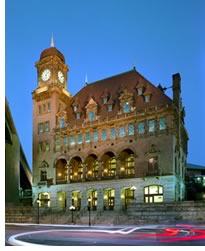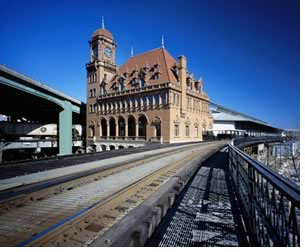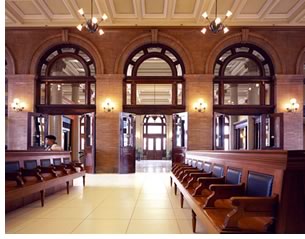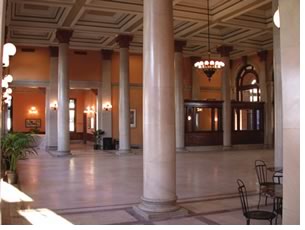

Historic Richmond Train
Station Restored to Former Glory
Gensler leads team that transformed Main
Street building into transportation hub and revitalization catalyst
 The
historic Main Street Station in Richmond, Va., reopened June 9 as a mixed-use
transportation hub, following an extensive renovation and restoration
program by Gensler. The architect’s design reversed the building’s
28 years of vacancy, restoring the five-story, 103-year-old landmark head
house, designed by Wilson, Harris & Richards of Philadelphia, and
creating a new elevated Amtrak platform. Gensler provided the project’s
historic preservation and renovation design, architecture, interior design,
and urban planning services; HC YU and Associates provided MEP engineering
services; Snead Associates was civil engineer; Daniels & Associates,
P.C. was structural engineer; and Sorg and Associates served as historic
preservation consultant.
The
historic Main Street Station in Richmond, Va., reopened June 9 as a mixed-use
transportation hub, following an extensive renovation and restoration
program by Gensler. The architect’s design reversed the building’s
28 years of vacancy, restoring the five-story, 103-year-old landmark head
house, designed by Wilson, Harris & Richards of Philadelphia, and
creating a new elevated Amtrak platform. Gensler provided the project’s
historic preservation and renovation design, architecture, interior design,
and urban planning services; HC YU and Associates provided MEP engineering
services; Snead Associates was civil engineer; Daniels & Associates,
P.C. was structural engineer; and Sorg and Associates served as historic
preservation consultant.
 “This
project is about more than restoring Main Street Station to its original
grandeur. It’s about balancing Richmond’s past with its future
and giving the city a practical transportation solution while bringing
new life to the surrounding Shockoe Bottom neighborhood,” says Uriel
Schlair, Gensler project manager. To make practical use of a structure
far too big for today’s more modest rail transportation needs, Gensler
converted the top three floors of the head house as office space and allowed
for new retail space within the building.
“This
project is about more than restoring Main Street Station to its original
grandeur. It’s about balancing Richmond’s past with its future
and giving the city a practical transportation solution while bringing
new life to the surrounding Shockoe Bottom neighborhood,” says Uriel
Schlair, Gensler project manager. To make practical use of a structure
far too big for today’s more modest rail transportation needs, Gensler
converted the top three floors of the head house as office space and allowed
for new retail space within the building.
“The restoration of Main Street Station exemplifies Richmond’s deep respect for history,” says Viktoria Badger, principal planner for the Richmond Department of Transportation. “The station is full of the memories of travelers from the past and has set a course for multimodal transportation options in the future.”
 The
architect designed Amtrak support areas to allow for expanded ridership
on the Northeast Corridor routes and the high-speed, East Coast Acela
train. Upgrades will integrate fully bus, trolley, airport shuttle, taxi,
and limousine services, making the station a significant multi-modal transportation
center. In addition, new parking areas offer convenience for travelers
who wish to park and ride. “This is a big plus for the business
community,” says Jim Dunn, president of the Greater Richmond Chamber
of Commerce. “Commuters can avoid traffic and get work done on their
way to Washington, D.C.”
The
architect designed Amtrak support areas to allow for expanded ridership
on the Northeast Corridor routes and the high-speed, East Coast Acela
train. Upgrades will integrate fully bus, trolley, airport shuttle, taxi,
and limousine services, making the station a significant multi-modal transportation
center. In addition, new parking areas offer convenience for travelers
who wish to park and ride. “This is a big plus for the business
community,” says Jim Dunn, president of the Greater Richmond Chamber
of Commerce. “Commuters can avoid traffic and get work done on their
way to Washington, D.C.”
Extensive research and restoration
The architect reports that restoring the 1901 head-house building, which
holds city, state, and national landmark designation, required exhaustive
research. Many of the building’s original features were destroyed
by floods, a large fire, a conversion to a discount shopping mall, and
even addition of a disco in the 1980s.
 The
team repaired or restored the exterior masonry, including Roman bricks,
terra-cotta ornamentation, and a limestone base to match the original
design. They also worked their magic on the interior: Carefully cutting
through many layers of paint helped determine the original color palette,
and photographic documentation throughout the station’s life helped
to establish the design of lost elements of the building.
The
team repaired or restored the exterior masonry, including Roman bricks,
terra-cotta ornamentation, and a limestone base to match the original
design. They also worked their magic on the interior: Carefully cutting
through many layers of paint helped determine the original color palette,
and photographic documentation throughout the station’s life helped
to establish the design of lost elements of the building.
The architect allowed deviations from strict historical accuracy only when the original design was technically flawed or when safety was an issue. The building and grounds now offer full accessibility, and original light fixtures are supplemented with new systems. New exterior lighting makes the building and its clock tower a major nighttime landmark. Although the new train platform itself is of precast concrete, the railings and support structure emulate original ironwork details, and the entire platform system rests on the original trestles. The team coordinated all restoration work with the State Historic Preservation Office and follows the Secretary of the Interior’s Standards for Treatment of Historic Properties.
Copyright 2004 The American Institute of Architects.
All rights reserved. Home Page ![]()
![]()
 |
||
| Photos © Ron Blunt
|
||